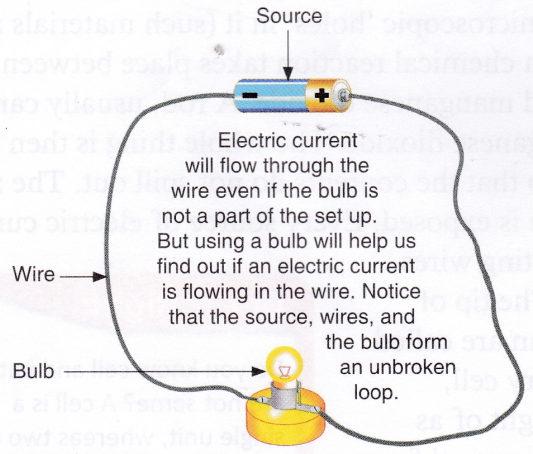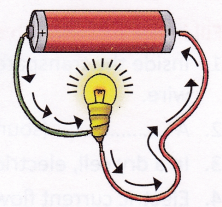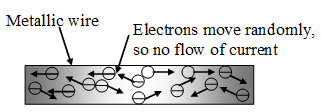Flow Of Current In A Metal
Flow of electric current
Three basic conditions are required for an electric current to flow.
A device used to produce an electric current like cell, battery, or a plug point acting as a source.
A wire made of a metal like copper, silver, or aluminium, which will allow electric current to flow through easily.
An unbroken loop (of the wire) running from one terminal of the source, through various appliances, back to the other terminal of the source.

Precaution: Never connect the two terminals of a cell with a wire without an appliance connected in a circuit. This will cause overheating of the wire and also destroy the cell.
Making a Simple Electric Circuit
When we connect the terminals of a pencil cell (name given to the cell due to its shape) to a bulb using two wires, the bulb glows. This happens because we provide a path for the current to flow. A path for an electric current to flow is called an electric circuit.
In Figure (a), one wire from the pencil cell is connected to the torch bulb, while the other wire is not. The electric circuit is not complete here. In Figure (b), both the wires from the cell are connected to the torch bulb. The electric circuit is complete in this case. Electric current flows only if there is an unbroken path or closed circuit starting from one terminal of the source, through the torch bulb, to the other terminal of the source. Thus, the bulb glows in Figure (b) but not in Figure (a). The circuit in Figure (a) is not complete. Hence, current cannot flow through the circuit and the bulb does not glow. Such a circuit is called an open circuit. The circuit in Figure (b) is complete. Electric current flows through the circuit and, as a result, the bulb glows. Such a circuit is called a closed circuit.

Electric current flows in a particular direction. In an electric circuit, the electric current flows from the positive terminal to the negative terminal of the electric cell. Figure 14.7 shows the direction of flow of electric current in a circuit.

Activity
Aim: To make a simple circuit (adult supervision required)
Materials needed: Electrical wire about 1 m (from your local electrical shop), pencil cell, small torch bulb (from your local electrical shop), blade, scissors, and sticky tape/ insulation tape (from the local electrical shop)
Method:
1. Cut out two pieces of the wire about 8 inches each, using scissors .
2. Strip the ends of the wire with a blade so that the metal is exposed.
3. You will see the signs’+’ and at the two ends of the pencil cell. These are the positive and negative terminals of the cell. Use sticky tape and attach one end of a wire to the negative terminal of the pencil cell.
4. Attach the other end of the same wire to the side of the bulb. Use a small piece of sticky tape to stick it well. Make sure that the bottom portion of the bulb is left open and also that the wire does not touch it. (You could also get a bulb holder and connect the wire to the two screws as shown in the picture.)

5. Take the second wire and attach one end of it to the positive terminal of the cell.
6. Touch the other end of this wire to the bottom end of the bulb and see what happens.
Observation: When you touch the bottom end of the bulb with the wire, the bulb will glow.
Note: Do not use any source other than a pencil cell for any of the activities given in this book. Using the electrical output at the plug points in your house or school could be extremely dangerous.
Flow of electric current in a metal
Metals show a very different kind of bonding called metallic bonding. According to this bonding, the outermost electrons are not bound to any particular atom, and move freely inside the metal randomly as shown in fig. So, these electrons are free electrons. These free electrons move freely in all the directions. Different electrons move in different directions and with different speeds. So there is no net movement of the electrons in any particular direction. As a result, there is no net flow of current in any particular direction.
 Fig. Flow of electrons inside a metal wire when no potential is applied across its ends
Fig. Flow of electrons inside a metal wire when no potential is applied across its ends
 Fig. Flow of electrons inside a metal wire when the two ends of a wire are connected to the two terminals of a battery
Fig. Flow of electrons inside a metal wire when the two ends of a wire are connected to the two terminals of a battery
Conduction of electricity
We get electricity in our homes through cables and wires. An electric cable consists of a number of metal wires with or without a plastic covering. The metal wires conduct or transmit electricity whereas the plastic covering do not. Materials that conduct electricity are called conductors. Materials that do not conduct electricity are called insulators. For example, metals are conductors of electricity; wood, air, and plastic are insulators.

